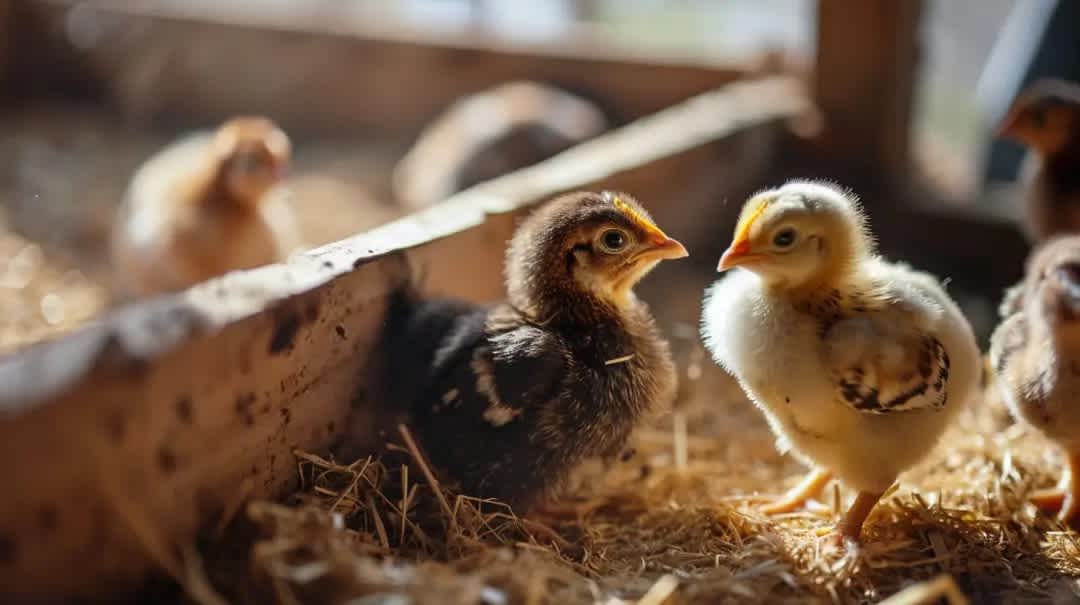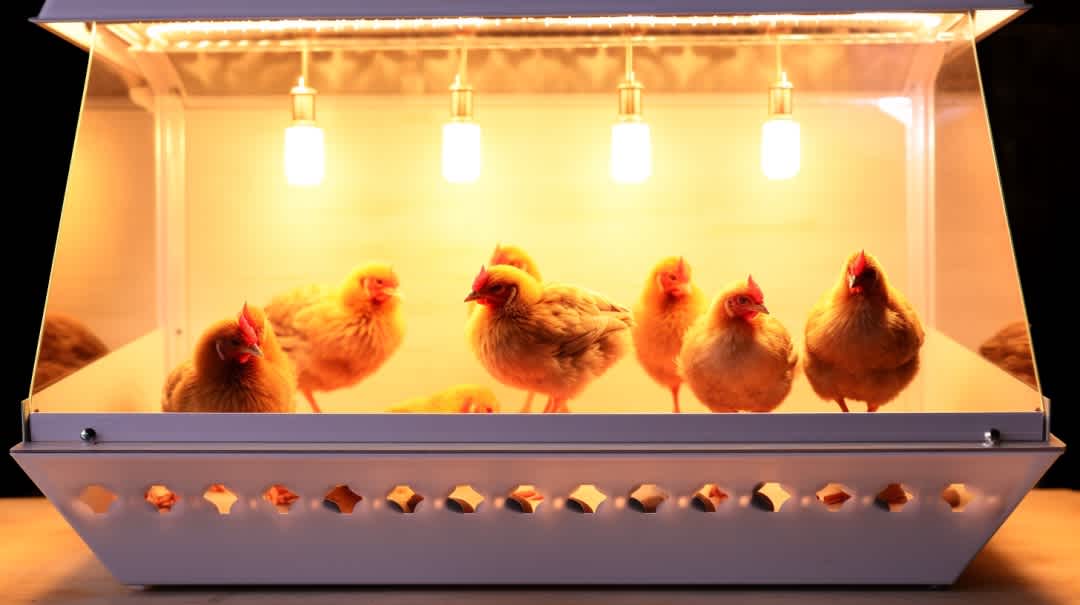Why 80% of Chick Brooders Fail: Avoid These Common Set-Up Mistakes
Published: December 21, 2023

Chick Brooders are essential to raising chicks, providing them with a warm and safe environment during their first few weeks of life. However, many people fail to set up their chick brooders correctly, resulting in a high mortality rate or unhealthy chicks.
The good news is, with the proper knowledge and preparation, setting up a chick brooder is relatively simple. This article will discuss the common mistakes people make when setting up a chick brooder and how to avoid them.
By the end of this article, you will have the necessary knowledge to ensure your chick brooder is set up correctly and that your chicks are off to a healthy start.
Essential Chick Brooder Elements: Avoiding Incomplete Setups

Ensuring you have all the elements for a chick brooder is essential. Without these elements, your chicks will not survive. The following are crucial elements that every chick brooder should have.
Heat Source
Chicks need a heat source since they cannot regulate their temperature during their first few weeks of life. Heat lamps or radiant heat plates are common options to simulate the heat the mother hen provides. Without it, they can quickly die from cold stress.
Structure
A brooder structure can be as simple as a cardboard box or as complex as a custom-built chick brooder. It must be secure to protect the chicks from predators and drafty conditions. The structure of your chick brooder is crucial in protecting your growing chicks from predators and harsh weather conditions. It also provides a safe space for the chicks to rest and grow. Simple enclosures are a popular choice.
Bedding Material
Bedding material is necessary to keep the chicks clean and absorb any waste. Popular choices for bedding material include pine shavings and straw. Litter, such as sand or dirt, is essential to absorb moisture from the bedding material. Bedding material keeps the chicks clean and serves as a cushion for their feet. Without it, their feet can become injured from walking on hard surfaces. The litter underneath the bedding also helps absorb moisture, keeping the brooder dry and helping safeguard against bacteria growth.
Water Container
Chicks require access to clean water for hydration. Running water or deep containers are unsuitable for chicks, as they can drown. A shallow dish or chick waterer filled with clean water is best for a chick brooder. Chicks always need access to clean water, as dehydration can be fatal.
Food Container
Proper nutrition is crucial in the growth and development of your chicks, so a food container is essential. Most feed stores offer chick starter feeds explicitly formulated for chicks. Proper nutrition is essential for the growth and development of your chicks. A lack of proper nutrients can result in stunted growth or even death.
If you miss any of these elements, your chick brooder setup is incomplete and may result in a high mortality rate.
Optimal Brooder Temperature: Preventing Overheating and Hypothermia
Maintaining the correct temperature in your chicken brooder is crucial to ensure your chicks' health and survival. However, many people struggle to maintain the optimal temperature, leading to overheating or hypothermia. The optimal temperature for chicks varies depending on their age, with younger chicks needing a warmer environment.
Ideal temperature range for a chick brooder
Below are the recommended temperature ranges for chicks based on their age:
Week 1: 90-95°F / 32-35°C
Week 2: 85°F / 29.4°C
Week 3: 80°F / 26.5°C
Week 4: 75°F / 23.9°C
Week 5: 70°F / 21.1°C
Week 6: 65°F / 18.3°C
After six weeks, the chicks should be fully feathered, able to maintain their body temperature, and no longer need a heat source.
How to maintain the correct temperature
You must have a reliable heat source and thermometer to maintain the correct temperature in your chick brooder. Here are some tips for keeping the temperature within the optimal range for raising chickens:
Adjusting the Heat Source: To increase or decrease the temperature, adjust the height of your heat lamps. A lower heat source will provide more warmth, while a higher one will provide less warmth.
Monitoring with a Thermometer: It's crucial to monitor the temperature regularly inside the brooder using a thermometer. This will help you make any necessary adjustments.
Provide Adequate Ventilation: Proper ventilation is essential to prevent overheating in the chick brooder. Ensure enough space for air to circulate so that heat can escape.
Brooder Bedding Choices: Selecting the Right Material
Choosing the proper bedding material for your chick brooder is vital for their health and comfort. By selecting the right material, you can prevent bacterial growth and foot injuries.
Different types of bedding materials
Each option has advantages and disadvantages and may depend on availability and personal preference. Here are some popular choices to consider:
Pine Shavings: Pine shavings are a popular choice for chick brooders. They are absorbent, easy to clean, and provide cushioning for the chicks' feet. The downside is that they can be dusty and cause respiratory issues if not kept clean.
Straw: Straw is another common bedding material that provides cushioning and is easy to clean. However, it can be less absorbent than pine shavings, and chicks eat it (among other items), potentially making the chicks sick.
Paper Pellets: Paper pellets are another highly absorbent alternative and easy to clean. They do not produce dust like other options, making them suitable for sensitive chicks. However, they can be more expensive and challenging to find.
Sand or Dirt: Some prefer to use sand or dirt as bedding and litter for their chick brooder. These options are readily available, allowing the chicks to explore and scratch naturally. However, they can be messy to clean and may not provide as much cushioning as other materials.
How to properly set up and maintain bedding
Whatever bedding material you choose, proper setup and maintenance are essential to keep your chicks healthy. Here are some tips for setting up and maintaining your chick brooder's bedding:
Provide a Thick Layer: The bedding should be at least 1-2 inches deep to provide adequate cushioning for the chicks.
Daily Spot Cleaning: Remove wet or soiled bedding daily to prevent bacteria growth and ensure a clean environment for your chicks.
Weekly Cleaning: Once a week, remove all the bedding and thoroughly clean and disinfect the brooder before adding fresh bedding.
Keep it Dry: Ensure the litter underneath the bedding remains dry by regularly checking and replacing damp areas. Wet bedding can lead to bacterial and fungal growth, harming your chicks.
Chick Brooder Size and Space: Ensuring Adequate Room for Growth
The size and space of your chick brooder are essential for the health and development of your chicks. A crowded chick brooder setup can lead to stress, aggression, and poor growth. On the other hand, too much space can cause temperature regulation issues.
Determining the right size for your brooder
Generally, a 3-foot-by-2-foot space is appropriate for up to about 20 new chicks, about 1/2 square foot per chick.
However small chicks are, it's crucial to consider the breed of your chicks and their expected size as they grow older. Some breeds of healthy chicks may need more room than others.
Importance of space in chick development
Providing enough food, water, and space for your chicks is vital to their development in many ways:
Less Stress: Crowded brooders can lead to stress and aggression among chicks, causing harm or even death.
Exercise and Muscle Development: Adequate space allows chicks to move around and exercise, promoting healthy muscle development.
Opportunity for Natural Behaviors: Chicks need space to explore, scratch, and peck, which helps keep them entertained and happy.
Proper Temperature Regulation: If there is not enough space in the brooder, chicks may struggle to regulate their body temperature, leading to health issues such as overheating or hypothermia.
Brooder Safety Measures: Protecting Your Chicks from Hazards
Keeping your chicks safe and secure in their brooder is crucial for their health and well-being. Here are some essential safety measures to consider:
Common safety risks in chick brooders
There are several hazards to be aware of when setting up and maintaining your chick brooder, including:
Heat Source Issues: Improper placement or malfunctioning heat sources can be a fire hazard or harm to chicks. Place heat sources away from bedding and other flammable items and regularly check them for issues.
Water Containers: Chicks can easily drown in deep water containers. Use shallow dishes with marbles or rocks covering the bottom to prevent drowning hazards.
Sharp Objects: Avoid using sharp objects and regularly inspect the brooder for wires, nails, or staples that can injure chicks. Be sure to remove them immediately if they are found.
Ventilation: Inadequate ventilation can lead to respiratory issues and even suffocation for your chicks.
Predators: If your brooder is outdoors, secure it with a lid or fence to protect it from wild animal predators.
Precautions for Children and Pets: If you have other pets or children around the brooder, ensure they are supervised and cannot harm the chicks. Educate them on the importance of being gentle and cautious around the baby chicks.
Following these tips can provide a safe and comfortable environment for your chicks to thrive in their brooder. Regularly monitor and maintain the bedding, space, and safety measures to ensure your chicks grow into healthy adult chickens.
Conclusion: Setting Up a Successful Chick Brooder
Creating a suitable brooder for your chicks is crucial for their well-being and proper development. Consider bedding, space, and safety measures when setting up and maintaining your chick brooder.
By following these guidelines, you can provide a comfortable and safe environment for your chicks to grow and thrive in their early stages of life.
With proper care and attention, your chicks will soon be ready to move into a coop and start their journey as adult chickens.
Supplementary Information
Below are some of the most common questions related to chick brooders and their answers:
What is a Chick Brooder?
A chick brooder is a specialized enclosure designed to provide a warm, safe, and comfortable environment for young chicks in their early stages of life. The brooder keeps your chicks protected, warm, and clean until they are ready to move into a coop.
Why is a Proper Brooder Setup Important?
A proper brooder setup is essential for the health and well-being of your chicks. It provides a safe and comfortable environment for them to grow, develop, and thrive. A poorly set up brooder can lead to stress, aggression, illness, and even death for your chicks.
Where to Buy Chick Brooder Supplies?
Specialized chick brooder supplies can be found at your local farm supply stores or ordered online.
Some commonly used items for a chick brooder include heat sources, bedding materials, containers, and temperature gauges. Ensure that high-quality and appropriate supplies are purchased for the best results.
When to Move Chicks from the Brooder?
Chicks can usually move from the brooder to a coop when they are 6-8 weeks old. However, this timeline may vary depending on the breed and individual chick's size and development.
Monitoring their growth and behavior is best to determine when they can transition into a larger space.
How to Clean and Store the Brooder?
Regularly cleaning and maintaining the brooder is essential to keep your chickens healthy. Remove soiled bedding, clean water and food containers daily, and sanitize the brooder once a week.
Once your chicks have outgrown it, clean and disinfect it thoroughly before storing it for future use. Store in a dry, well-ventilated area to prevent mold or bacterial growth.
Keep track of all your cattle with the #1 Cattle Management Software
Try out Ranchr today for free